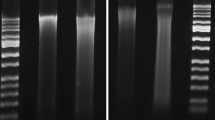Abstract
The high polysaccharide content of some plant species hinders the successful isolation of their DNA. As an alternative to the macro-extraction methods previously published for polysaccharide-rich plants, we present two techniques (STE/CTAB and HEPES/CTAB), which are performed in microcentrifuge tubes. These protocols are suitable for small amounts of silica gel-preserved plant tissue such as are commonly available from endangered plants. The critical step to remove polysaccharides was performing initial washes in either STE (0.25 M sucrose, 0.03 M Tris, 0.05 M EDTA) or HEPES (2% β-mercaptoethanol, 0.2% PVP, 0.1 M HEPES, pH 8.0) buffer. Precipitating the DNA at room temperature with isopropanol also aided in decreasing polysaccharide co-precipitation. Of the two protocols we present the STE/CTAB method has the advantages of being more cost-effective and avoiding the use of the hazardous chemical β-mercaptoethanol.

Similar content being viewed by others
References
Barnwell P, Blanchard AN, Bryant JA, Smirnoff N, Weir AF (1998) Isolation of DNA from the highly mucilaginous succulent plant Sedum telephium. Plant Mol Biol Reptr 16:133–138
Bayer C, Fay MF, De Bruijin AY, Savolainen V, Morton CM, Kubitizki K, Alverson WS, Chase MW (1999) Support for an expanded family concept of Malvaceae within a recircumscribed order Malvales: a combined analysis of plastid atpB and rbcL DNA sequences. Bot J of Linnean Soc 129:267–303. doi:10.1111/j.1095-8339.1999.tb00505.x
Cota-Sánchez JH, Remarchuk K, Ubayasena K (2006) Ready-to-use DNA extracted with a CTAB method adapted for herbarium specimens and mucilaginous plant tissue. Plant Mol Biol Reptr 24:161–167
Crowley TM, Muralitharan MS, Stevenson TW (2003) Isolating conifer DNA: a superior polysaccharide elimination method. Plant Mol Biol Reptr 21:97a–97d
de la Cruz M, Ramirez F, Hernandez H (1997) DNA isolation and amplification from cacti. Plant Mol Biol Reptr 15:319–325
Doyle JJ, Doyle JD (1990) Isolation of plant DNA from fresh tissue. Focus 12:13–15
Drábková L, Kirschner J, Vlček C (2002) Comparison of seven DNA extraction and amplification protocols in historical herbarium specimens of Juncaceae. Plant Mol Biol Reptr 20:161–175
Fang G, Hammer S, Grumet R (1992) A quick and inexpensive method for removing polysaccharides from plant genomic DNA. BioTechniques 13:52–56
Ghosh R, Paul S, Ghosh SK, Roy A (2009) An improved method of DNA isolation suitable for PCR-based detection of begomoviruses from jute and other mucilaginous plants. J Virol Methods 159:34–39. doi:10.1016/j.jviromet.2009.02.020
Kaufman B, Richards S, Dierig DA (1999) DNA isolation method for high polysaccharide Lesquerella species. Ind Crop Prod 9:111–114. doi:10.1016/S0926-6690(98)00021-1
Michiels A, Van den Ende W, Tucker M, Van Riet L, Van Laere A (2003) Extraction of high-quality genomic DNA from latex-containing plants. Anal Biochem 315:85–89. doi:10.1016/S0003-2697(02)00665-6
Perrie LR, Shepherd LD (2009) Reconstructing the species phylogeny of Pseudopanax (Araliaceae), a genus of hybridizing trees. Mol Phylogenet Evol 52:774–783. doi:10.1016/j.ympev.2009.05.030
Remya R, Syamkumar S, Sasikumar B (2004) Isolation and amplification of DNA from turmeric powder. Br Food J 106:673–678. doi:10.1108/00070700410558201
Ribeiro RA, Lovato MB (2007) Comparative analysis of different DNA extraction protocols in fresh and herbarium specimens of the genus Dalbergia. Genet Mol Res 6:173–187
Sawyer JWD (2004) Plant conservation strategy: Wellington Conservancy (excluding Chatham Islands) 2004–2010. Department of Conservation, Wellington
Setoguchi H, Ohba H (1995) Phylogenetic relationships in Crossostylis (Rhizophoraceae) inferred from restriction site variation of chloroplast DNA. J Plant Res 108:87–92
Sharma AD, Gill PK, Singh P (2002) DNA isolation from dry and fresh samples of polysaccharide-rich plants. Plant Mol Biol Reptr 20:415a–415f
Shepherd LD, Perrie LR, Brownsey PJ (2007) Fire and ice: volcanic and glacial impacts on the phylogeography of the New Zealand forest fern Asplenium hookerianum. Mol Ecol 16:4536–4549. doi:10.1111/j.1365-294X.2007.03451.x
Varma A, Padh H, Shrivastava N (2007) Plant genomic DNA isolation: an art or a science. Biotechnol J 2:386–392. doi:10.1002/biot.200600195
Acknowledgments
This study was funded by the New Zealand Marsden Fund (contract number MAU0709). We thank Peter Lockhart and Leon Perrie for comments on the manuscript.
Author information
Authors and Affiliations
Corresponding author
Rights and permissions
About this article
Cite this article
Shepherd, L.D., McLay, T.G.B. Two micro-scale protocols for the isolation of DNA from polysaccharide-rich plant tissue. J Plant Res 124, 311–314 (2011). https://doi.org/10.1007/s10265-010-0379-5
Received:
Accepted:
Published:
Issue Date:
DOI: https://doi.org/10.1007/s10265-010-0379-5




